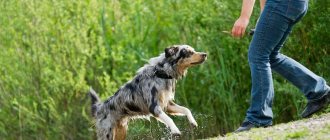How to teach a dog to guard the yard and make it bark?
In its literal sense, an instruction does not require the animal to perform specific actions, but puts it into a state of alertness or high alert.
You can start classes only after learning simple commands, such as “Sit”, “Lie down”, “Stand”, etc. provided that the latter are well studied and the animal obeys the first time.
The ideal age is six months and older; before this time it is better not to get carried away with training malice or aggression, otherwise the animal will grow up nervous and intimidated.
How to teach your dog the “down” command
The “Lie down” command is learned with a pet using a similar method. The dog is shown a treat held in the left hand, then this hand is lowered to the floor, at the same time the command “Lie down” is given, and the right hand presses on the dog’s withers, thereby forcing it to lie down. As soon as the required position is achieved, the treat is immediately given and praise follows, interspersed with the repetition of the learned command “Lie down”.
Beginners (and not only) in the process of this training often make the mistake of allowing the dog to take any lying position. You should not allow your pet to fall over on its side when lying down; you need a clear position: paws forward, muzzle above the paws. Correct the dog as many times as necessary, and give treats only for correct performance.
Is it worth learning
Before making a decision to teach or not to teach, you need to clearly determine for yourself whether it is really necessary to develop aggression in your pet and whether it can be subsequently controlled.
With improperly structured training, especially with dogs of an unbalanced excitable type, it is very easy to disrupt the psyche and instead of an obedient and friendly dog, you can “raise” an angry and uncontrollable beast.
This is how it was noticed:
- Dogs of large, service breeds undergoing training, even without targeted training, will protect their owner in dangerous situations, especially if friendly relationships have been established between them.
- On the other hand, small animals or representatives of decorative breeds, although they easily learn to show an active defensive reaction, but what is the point of this? Its non-intimidating appearance and small dimensions are unlikely to frighten anyone much.
- Problems are possible when inept training leads to hostility towards the owner or family members and such an animal literally becomes a killing machine.
There are also positive aspects: the puppy, and subsequently the adult animal, ceases to fawn and trust all passers-by or strangers appearing on its territory.
When to start learning the Alien command
Before teaching a dog a stranger’s command, you need to learn a number of rules:
- ZKS is a set of commands for an adult dog or teenager, but not for a puppy. By developing aggression in a puppy not “for fun”, you risk the safety of your family and the people around you.
- The command is difficult to master and it is highly not recommended to practice it only on your own if you do not have the appropriate canine experience.
- Before training, it is recommended to consult with a dog trainer. A professional will understand the dog’s psychotype and degree of excitability by observing it on the site and will give recommendations for training.
- Do not teach your dog the “Stranger” command at home, and do not involve family members.
- Do not approve of a dog barking under the door, a loud growl at most. Contrary to popular belief, you will not reinforce the “Alien” command, but a “bad habit” that is really hard to break.
- Only a person unfamiliar to the dog, dressed in a special suit and hiding his face with a mask, can act as a bandit.
- Before starting the ZKS course, the dog must undergo a general training course (general training course), unquestioningly follow the commands Fu, Come to me, Sit, Lie, Near, Place.
Scheme of work
Teaching a dog the “Stranger” command is only possible with the help of helpers. It is important that they are not family members or close friends.
It is best for the classes to be conducted by an experienced instructor who will first determine the type of nervous activity of the dog and generally understand whether it is worthwhile to develop anger with a particular animal or not.
First of all, even before targeted training, it is necessary to ensure that the animal does not have contact from infancy, and certainly does not play with strangers. To do this, it is necessary to prohibit all friends and acquaintances from communicating with the pet; moreover, they must ignore the presence of the puppy. All attempts to fawn are warned by a weak tug on the leash and the warning command “Alien.”
Upon reaching the required age and subject to impeccable obedience to other commands, you can begin classes to develop anger, distrust and wariness towards strangers.
To do this, they involve assistants who are equipped with special protective equipment. The first classes are conducted in a quiet, familiar environment without distracting stimuli.
- The animal is kept on a short leash.
- The helper approaches those standing and shows aggression in any way: he waves his arms or a stick, while actively showing that he is afraid of the dog.
- At the same time, while continuing to hold the dog on the chain, they pronounce the command “Alien”. It is very important to use intonation to convey to the animal about the existing threat.
- If the pet shows any kind of hostility (growling, barking, or the dog begins to rush at the “stranger”), repeat the command again and reward the animal with a treat.
After a while, when the animal completely calms down and comes to its senses, the exercise is repeated. You cannot conduct lessons more often than two or three times in one lesson.
Preparing to teach a dog the “stranger” command
First of all, you need to decide what exactly you want to achieve by teaching your dog this command. In the event of an attack, hooligans can often be scared away with just the threatening growl and barking of a dog. However, despite this, we cannot be sure that bullies will be afraid of this, especially if the dog is not large in size. In order to be sure that the attacker will be detained, and you will remain one hundred percent safe, you need to teach the dog the “stranger” command, which will make the animal understand that this is not a good person in front of him, and the owner needs to be protected from him. By the way, a similar function can be performed by the dog’s ability to obey the “front” command, but it has more aggressive consequences than the “stranger” command.
Also keep in mind that not every dog can detain a criminal. Representatives of fighting breeds, which include shepherds, Rottweilers, Dobermans and large terriers, are most capable of this.
Many inexperienced owners make a big mistake when they start teaching this difficult command to a small puppy. It is extremely inadmissible to awaken aggression in a baby, since the animal’s psyche is not yet strong enough to perceive everything adequately. By making your puppy angry, you endanger both yourself and those around you, as in the future, rest assured, this will lead to uncontrollable outbursts of anger in the dog.
Also, you should not involve family members in the process of teaching this command, since the dog will consider it normal to show aggression towards them.
If the dog is not aggressive
There are animals that do not show any malice towards a stranger. In such situations, it is necessary to compromise and bring in heavy artillery. Here are some ways:
- the assistant “attacks” the owner;
- the assistant imitates taking away food from the owner, which is intended for the dog;
- During the “attack” the ill-wisher inflicts light blows on the animal.
It is important not to overdo it with physical violence: the animal develops malice, not cowardice. Therefore, blows should not be strong or cause severe pain - they should only inflame aggression and active defense.
It is for this reason that the assistant must be experienced and carefully monitor the student’s behavior, and if necessary, retreat in time so as not to overwhelm the dog. The dog must always remain a “winner”!
Naturally, at the moment of manifestation of any kind of wariness or malice, they pronounce the command “Stranger” and reward the animal in a convenient way (affection, encouraging words, treats). It is advisable not to abuse taste rewards.
After some time, the animal develops an active defense, it becomes distrustful of any stranger and is no longer afraid of blows.
Other training methods
There are alternative methods for teaching a dog the “Alien” command:
- If during a walk the animal independently shows hostility towards a person passing by, then at the same moment the words of the command are pronounced.
- Again, during the walking process, they use the method of surprise, which helps even the most timid pet to awaken the beginnings of protective behavior. To do this, the assistant sneaks up behind the dog and lightly pinches its croup or belly, at the same moment the trainer says “Stranger.” Important: the student must be muzzled, while carefully monitoring the pet’s behavior - this method may not always lead to the desired result and instead of malice, caution will be practiced, and the dog will look around in fear of getting another blow.
Learning the correct reaction to strangers
When the dog already knows the “voice” command, it must be taught the correct reaction to strangers. To do this, you will need an assistant who will produce a noise effect near the door to the apartment or the gate to the yard.
For example, he will knock, pull the handle, and so on. At this time, the owner must give the command “voice”, and then the command “guard”, so that the dog understands that in this case it is necessary not only to bark, but also to take some other actions. After this happens, the “intruder” behind the door should quiet down.
At this point, the dog should receive praise or a treat. This training should be repeated several times until the owner is convinced that all commands are being followed. Right
Possible mistakes
Mistakes always lead to undesirable and unexpected results - improper training will lead to excessive aggression, and superimposing malice on natural cowardice can cost the life of the owner or those around him.
- Protection training begins after six months of age (the later the better). Until this moment, the pet must live and grow exclusively in friendly conditions.
- Only strangers are recruited as assistants. By the way, the assistant in each lesson should be different, otherwise an active defensive reaction will be developed exclusively against a specific person.
- During work, the animal is not allowed off the leash and is not allowed to attack an ill-wisher.
- Training is carried out only after mastering the basic disciplinary commands: “Sit”, “Come to me”, “Fu”, “Next”, etc.
- Punishment cannot be applied in the absence of correct actions, otherwise the animal will be even more afraid.
- Also, you should not punish your pet if he continues to show good nature to the first person he meets. At such moments, the puppy is distracted, and people are forbidden to make any contact with the baby.
With the right approach, the “Alien” command can be useful in everyday life: it will not give the opportunity to steal an animal, and a growl can scare an intruder, which will ultimately protect the owner from attack.
—>
Dog training and behavior
How to teach a dog to bark at strangers
13-09-2018 41 0.0 0
This is an easy skill. It is taught based on the instinctive guarding behavior that is present in all dogs. And the more the dog is distrustful of strangers, the faster the training will go.
In this article we will talk specifically about learning to bark at strangers; we will not touch upon attack and defense, this is a completely different topic.
Even a peace-loving dog can be taught to bark menacingly; they usually enjoy the process of barking.
Why teach such a skill?
A dog, although inclined to protect its owner, of course, cannot be considered a full-fledged bodyguard. However, a large breed can scare away an unpleasant passerby only with its appearance and loud barking.
Teaching method
1. It is more convenient to first teach the dog the “Voice” command without the participation of strangers. Tease with a treat or toy until your dog starts barking. Simultaneously say the command and praise when the dog barks.
2. Get a helper. Better than someone the dog doesn’t know well or hasn’t seen before.
Training and education of the German Shepherd
Take your dog on a leash and pull it slightly. At this moment, have the assistant come out from around the corner and walk towards you with a springy, threatening step, sometimes freezing in a tense position. His gait should be different from usual. The dog will focus on him, some already at this stage begin to bark. Walk forward a little with the dog, give the command “Voice”. The helper must be attentive - when the dog barks, he immediately turns around and runs away from you. And you praise your pet intensely.
Do at least five repetitions. Each time the dog will begin to behave more confidently, and its barking will become louder and more menacing.
3. The next command is “Stop!” It is needed to stop barking. Once in a rage, it can be difficult for a dog to stop; it may even try to chase a person, but this should not be allowed. Once the helper is out of sight, pull the dog towards you with the leash, say “Stop,” and clamp his jaw to physically stop the barking. Additionally, you can sit the dog down to calm it down.
4. After a couple of weeks of training, take the exam. Ask another person for help, check the execution of the “Voice” command. In the future, every few weeks, invite friends to maintain the skill.
A dog trainer I know told me a story about a dog who protected its owner in a dangerous situation. It was in the Middle East, a girl came with her Belgian Shepherd to a seminar and during a walk a couple of people became attached to her, started pestering her and tried to push her into the car. The dog swooped in like a hurricane and instantly dealt with both attackers, frightening them very much.
But this is still an exception to the rule and there is no need to rely on the dog as an ideal protector. You can always stumble upon a person who knows how to handle dogs and your dog will not be able to do anything with him.
Teaching a dog to bark at strangers is not at all difficult; the biggest difficulty you will have is finding a good helper who will perfectly fulfill his role. 50% of success depends on it. Good luck with your training, and if you are completely unsuccessful, then contact a professional instructor.
How to teach a dog to stop taking food from strangers?
Thousands of dogs die at the hands of dog hunters and simply ill-wishers. How to teach a dog not to take food from strangers and not become a victim of a person who will either poison the animal or simply steal it? How to train a dog to eat with one hand?
The last question contains the answer: from the very moment it appears in the house, a puppy (or an adult dog) should eat exclusively from the owner’s hands. Only as an exception will the trainer give you a treat if you go to a training group, and even then, only at the very beginning to demonstrate a particular command. Only one owner should feed and give treats!
How to teach a dog to guard the yard
If you buy a dog so that it will guard your private property and enhance security, then from early childhood you need to start training it for such work.
Typically, service breed dogs are purchased for such purposes. Their mere presence in the yard will deter intruders. But sometimes even yard dogs, not purebred dogs, perform excellent security service if they are trained for this in time and correctly. So, let's learn about this process. It is important to consider that guard dogs can be more aggressive. Therefore, you first need to achieve obedience from your pet, which will avoid possible troubles.
Step #1 is obedience. This is the basis for training a dog to protect territory. It is necessary to explain to the pet that the owner is always in charge. Obedience is the dog’s unquestioning execution of the commands “come”, “no” or “fu”, “near”, “sit”, “place”. Your pupil must be accustomed to walking on a leash. When training, you must use motivation in the form of treats.
Step #2 - Set clear boundaries. The pupil must protect the yard and house and not let strangers in, but outside of it the dog must behave calmly. To do this, every day you need to take the pupil for walks outside the site, let him off the leash and reinforce commands.
Step No. 3 - socialization of the dog. In order for your pet to understand when there is a threat to the territory and yard that he is protecting, you need to introduce him to the people who come to visit you, the neighbors. In this case, you need to stay close to the dog and control his actions. The dog should also know a variety of noise sounds, for example, the noise of a vacuum cleaner, lawn mower, or power tools that you use. In front of the dog you need to open and close a push-button umbrella and move objects. That is, he should not react by barking to actions that do not pose a threat to the protected area.
Step 4 - praise for barking at strangers. When a stranger enters the yard, the dog should react loudly. The owner rewards him for this with praise, stroking, and treats.
Step 5 - teach not to take food from strangers. Surely everyone knows that thieves and criminals very often put watchdogs to sleep before robberies. For this purpose, the dog is offered meat products with sleeping pills. Therefore, one person should always feed the watchdog. And do not allow guests of your home, strangers, to feed your pupil.
Step 6 - learning to react to strangers. For this you will need a volunteer assistant. He must approach the protected area and make noise sounds of entry (knocking, opening a gate). At this time, the owner gives the command “guard!”, and the dog usually begins to react by barking, which intensifies. Then the “intruder” should calm down for a while behind the fence and do nothing. At this time, you give the dog a treat and praise him. Then the training is repeated. The owner controls the dog’s actions and repeats commands.
Step 7: Train your dog for active defense. To do this, the volunteer assistant must be prepared for a dog attack. Of course, this is a risky training and it is better if such a person is a specialist in training service dogs. The “intruder” now not only imitates noise, but also penetrates the yard. He must attempt to attack the dog if it does not do so first. The assistant gives you the opportunity to pat yourself on the sleeve or clothes. If the dog belongs to the category of purebred guards, then it will probably not just let go of the “intruder” and will hold it with its teeth until the owner arrives. Praise the student for his service and reward him with a treat. The skill needs to be repeated and reinforced, then your dog will never allow strangers into the yard.
Step 8 - use the services of a dog training center if you cannot teach your dog to guard the territory on your own, and you do not want to risk the lives of your friends by training him to guard.
It’s also worth hanging a sign on the fence that will inform you that the territory is guarded by a service dog. Such a warning scares off many intruders, and from a legal point of view, it protects you from liability for the fact that the dog may bite a stranger who enters the yard.
How to stop a dog from taking food from strangers?
- Only the owner feeds. It is important! Don’t even let your friends pamper “such a cute fluffy little furball” with goodies.
- Weaning off picking up from the floor. First of all, you need to wean yourself from picking up food from the ground, and only then teach the dog not to take food from strangers. Read more about weaning in the article at the link. By the way, before 3 months you can’t wean him off picking up from the floor and, especially, from someone else’s hands.
- Teach a puppy from 3 to 5 months not to take food from someone else's hands as follows. Place the puppy near your left leg, saying “sit” (for this you need the command to sit). Ask your friend or acquaintance to offer the puppy a piece of tasty food (sausage, smoked sausage, etc.) and hold it near the puppy’s nose for 5-10 seconds. As soon as the puppy tries to take food, give a strict command “fu” and jerk the leash towards you.
- Have your friend offer food to the puppy again. Did he try to eat her again? Then say “ugh” again and give an even more severe jerk with the leash. To quickly achieve results, try to understand how to teach your dog commands using a mechanical stimulus. The jerk should be strong enough so that the next time a friend offers food, she thinks: “If I take the food, I’ll get it in the neck from the owner.” I’d rather not take it.”
- It's rude, but we don't do it out of malice! If the puppy refuses to eat next time, be sure to give him an even more delicious treat from your hands. The animal must know that if the owner refuses to take it from someone else’s hands, it will receive something much tastier.
Puppies from 5 months and adult dogs wean themselves from taking food from strangers using more aggressive methods. Let your friend, preferably not the person the dog sees often, offer a piece of treat from your hand and hold it under the dog’s nose for 10-15 seconds. As soon as the dog tries to take the food, he will immediately receive a noticeable slap in the face. Don’t overdo it with force, find the “golden mean”. If the dog tried to eat it again after giving food to strangers, let the helper slap him even harder.- You must stand with the dog next to your left leg the entire time. If the animal turns away from the offered treat, have the helper move a few steps back, and you generously praise the dog and give a tasty treat.
- If the animal gets up and hides behind you in response to the food offered by the helper (for 10-15 seconds), let the helper step back, and you praise the dog with a treat. It's already very good that she doesn't take food.
- If a dog behaves aggressively in response to an offered treat, then the owners of breeds that are not characterized by aggression should not be too strict, but prohibit aggression with the command “fu”. Make sure that the dog may growl, but does not rush at the person.
- For example, a helper offered food, and the dog began to growl for it - encourage it and give treats. If she rushes, also reward with your voice, and after rewarding (after 4-5 seconds), sit the dog near your left leg with the command “sit”, and then praise generously again and give a tasty treat. Learn to control any dog aggression, otherwise you will be in trouble!
That is, refusal of food should be encouraged even if the dog behaves aggressively. If she rushes at the helper for the offered food, for such aggression it is better to give a not very strict, prohibitive command “fu” instead of a treat. Thanks to the persistent actions of the owner, the dog will understand that there is no need to react to the offered treat with an attack. Owners of serious breeds intended to protect the owner and protect them must encourage the pet’s aggressive behavior in response to a treat offered by a stranger.
How to teach a dog to guard its owner?
Even the smallest dog can be a reliable protector of its owner if it gets used to it and loves it, if it really becomes its leader. After all, by nature, dogs are pack animals. And the leader in the pack is an inviolable figure, the most important. Members of the pack suppress any encroachments on him and his territory. That is why the dog will instinctively protect the owner as the leader of his small flock. This applies to the poodle, labrador, and terrier.
Guarding instincts must be developed in dogs from an early age. But you should not awaken aggression in a young pet. And it is strictly forbidden to set him on strangers, random passers-by. This way you can only break the animal’s psyche, spoil its character, and ultimately raise an uncontrollable pet that will attack everything that moves. To prevent this from happening, the puppy must first be taught the prohibitive command “fu”. It will help correct the behavior of a dog that is trying to bite or attack its owner’s abuser. A prohibiting command and the command “sit” or “stand” will help to stop the dog in such an impulse. They are included in the general training of the animal and teach it to be adequate. The “stranger” command helps train a dog to protect its owner. It must be used in cases where there is a knock on the door. In response to a knock, the dog must raise its voice and bark. Knowing this command, the guard will bark to scare away the person who dares to threaten the owner. The latter will only need to say “stranger.”
If your dog is from the service category, then mastery of the above commands will provide reliable protection to the owner. But if the dog does not belong to such people, then he must also be taught the “Face” command. It is better to entrust this to an instructor who knows proven techniques. He conducts classes on the site and teaches how to flawlessly protect the owner.
how to teach a german shepherd a stranger command
After 1-2 months, let the dog be offered more treats, and see how he reacts. Perhaps we need to work on weaning some more.
II. Development of aggression. Remember that if you encourage the dog to try to attack the helper for the offered treat, then by approving the actions you are developing anger. Uncontrolled anger is dangerous for others and the owners themselves, so a serious approach to obedience is necessary. Training is very important and will help keep your dog's behavior and anger in particular under control. Just train and ensure that commands are followed, then the dog will be perfectly obedient and you will use its aggression only at the moment of need, and not when it wants it.
After teaching the dog commands, you will need to go to a dog handler who will give a course on protecting the owner. Depending on your achievements, several obedience classes will be needed. First you need to learn to control the dog, since it is not difficult for even the most timid and hopeless creature to develop anger! Read more in the article about how to teach a dog the “front” command at the link.
III. Provocation. The helper must be persistent in offering food if the dog refuses. Let him put the food closer to his nose and say something affectionate, like: “My dear! Here, eat." That is, you should imitate the real situation.
That's all. Working out this command is not as difficult as it might seem. In any case, the effort invested is worth the dog's life. By the way, before training, get in a good mood and watch how the kid in the video below is trying to take food from the dog











